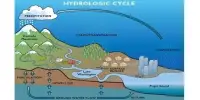Air stagnation is a meteorological phenomena in which air flow in a certain area becomes limited or static. It is a meteorological situation in which there is a lack of atmospheric movement, resulting in the buildup of pollutants and particles that can degrade air quality in a certain region. This phenomenon frequently arises when a high-pressure system settles over a region, trapping air near the surface and preventing it from circulating effectively. As a result, pollution and other airborne particles may build, resulting in poor air quality.
This condition is generally associated with air pollution and poor air quality due to the potential health implications to humans and the environment. Pollutants in the air, whether gaseous (such as ozone) or particle (such as soot or dust), cannot be removed due to low breezes and a lack of precipitation.
Causes
Air stagnation events usually occur in warm high-pressure systems, where conditions are stagnant and there is minimal vertical and horizontal air movement. Pollutants collect near the surface in a steady air environment. These pollutants include both gaseous and particle pollution, such as O3 at ground level and PM2.5.
Ground-level ozone and particulate matter come from a variety of sources, including human activities such as power plants and refineries, which damage the environment around the afflicted area. With restricted dispersion and a lack of air mixing, contaminants accumulate and remain stationary for days.
How to mitigate
During periods of air stagnation, pollutants from sources such as car emissions, industrial activity, and wood-burning can accumulate in the atmosphere, posing health risks to those living in the afflicted area. In addition to air quality concerns, air stagnation can cause fog, haze, and temperature inversions.
The National Climatic Data Center defines stagnation occurrences as having light low level winds, light upper level winds, and a lack of precipitation. These climatic circumstances demonstrate how atmospheric circulation and precipitation patterns interact with air stagnation occurrences.
To alleviate the consequences of air stagnation, authorities may issue advisories or warnings, recommending people to reduce their outside activities, particularly those requiring hard physical exertion. Furthermore, taking steps to reduce emissions from vehicles, industry, and other sources can assist improve air quality and mitigate the effects of stagnant air conditions.
















